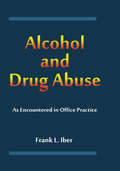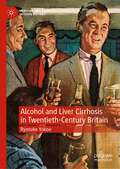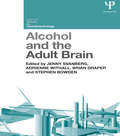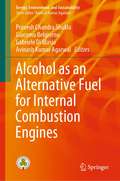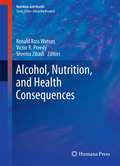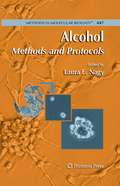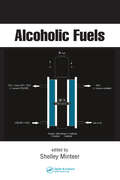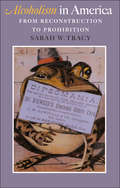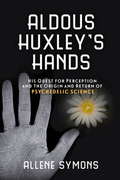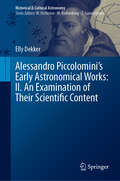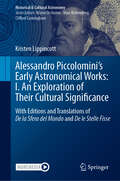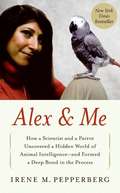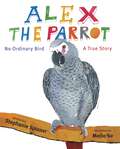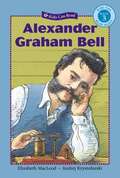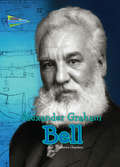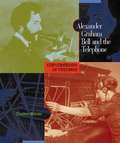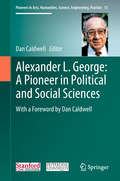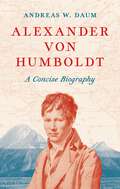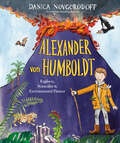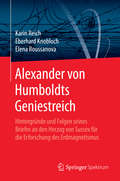- Table View
- List View
Alcohol and Drug Abuse as Encountered in Office Practice
by Frank L. IberThis book has been written to serve as a manual for physicians practicing in a private office setting to recognize and recommend appropriate treatment for patients believed to be substance abusers. While it is not written for drug abuse specialists, it provides information regarding the diagnosis and treatments a competent, concerned physician can provide without becoming immersed in addiction treatment. Topics discussed include the degree to which a physician should become involved, when it is appropriate to refer, using other professions and volunteer groups, and useful medications. Guidelines for recognizing substance abuse, testing to confirm the abuse, confronting the patient, and motivating the patient into specific treatment are also presented. Tables and illustrations are used to summarize major points, making this an extremely useful reference tool for internists and other non-specialist private practitioners.
Alcohol and Liver Cirrhosis in Twentieth-Century Britain (Medicine and Biomedical Sciences in Modern History)
by Ryosuke YokoeThe relationship between alcohol consumption and liver cirrhosis has long been contested by doctors and medical professionals, creating numerous implications for the public reputation of alcohol in Britain. Despite this, it was not until the 1970s that cirrhosis came to be understood as an ‘alcoholic disease’. This book contextualises developments in this debate through the twentieth century by examining the significant influence that medical expertise had on policy responses to alcohol misuse, as well as the social reputation of alcohol consumption. It demonstrates how the degree to which drinking was seen to be responsible for liver disease directly shaped how different groups, such as the temperance movement and the drinks industry, exaggerated or downplayed the destructive properties of alcohol. Covering a series of themes including the science of disease causation, the social standing of medical expertise, and alcohol and public health policy, this book argues that in order to properly understand the trajectory of debates around drinking we need to consider the twentieth-century ‘alcohol problem’ as primarily a medical issue. Contrary to the tendency by existing works to disassociate perceptions and responses to alcohol use from the objective knowledge of its effects on the body, this book shows that medical understandings of liver disease influenced how alcohol was conceptualised in relation to its harms. Offering a fresh perspective on the interaction between scientific knowledge and policy during the twentieth century, this book provides insights for those researching the social, political and cultural history of modern Britain, as well as historians of medicine and health.
Alcohol and the Adult Brain (Current Issues in Neuropsychology)
by Brian Draper Jenny Svanberg Adrienne Withall Stephen BowdenThe research literature on the impact of alcohol on the brain has seen a rapid expansion in recent years. Alcohol and the Adult Brain presents an up-to-date overview of some of the issues relevant to understanding and working with people with cognitive impairment as a result of chronic alcohol use. One issue causing barriers to effective treatment and care is the stigma associated with alcohol dependence, resulting in the belief that difficulties associated with alcohol related brain damage (ARBD) are ‘self-inflicted’. Cognitive changes resulting from alcohol excess and poor nutrition can directly affect an individual’s ability to motivate themselves, make decisions, and make the informed choices that underlie behaviour change. Attitudes held by professionals, reinforced by societal norms, that a person is ‘choosing to drink’ and ‘not motivated to engage with treatment’, in combination with the often subtle cognitive deficits associated with ARBD, can result in a lack of timely intervention, with enormous personal, social and economic cost. The chapters in this book set ARBD in a social and cultural context, provide discussion of the difficulties in definition and diagnosis, and outline the structural brain changes and neuropsychological deficits associated with chronic alcohol use. The book provides an overview of recent research on ARBD, including impairments associated with Wernicke-Korsakoff Syndrome, and discusses up to date recommendations for managing and working with this complex and varied disorder. Alcohol and the Adult Brain will be essential for students and researchers working with ARBD and for practitioners in a range of health, social care and voluntary settings.
Alcohol as an Alternative Fuel for Internal Combustion Engines (Energy, Environment, and Sustainability)
by Avinash Kumar Agarwal Pravesh Chandra Shukla Giacomo Belgiorno Gabriele Di BlasioThis book covers different aspects related to utilization of alcohol fuels in internal combustion (IC) engines with a focus on combustion, performance and emission investigations. The focal point of this book is to present engine combustion, performance and emission characteristics of IC engines fueled by alcohol blended fuels such as methanol, ethanol and butanol. The contents also highlight the importance of alcohol fuel for reducing emission levels. Possibility of alcohol fuels for marine applications has also been discussed. This book is a useful guide for researchers, academics and scientists.^
Alcohol, Nutrition, and Health Consequences (Nutrition and Health)
by Victor R. Preedy Ronald Ross Watson Sherma ZibadiChronic alcohol use is associated with heart, liver, brain, and other organ pathology. Alcohol is a drug of abuse and a caloric food and it causes poor intake and absorption of nutrients, thus playing a major role in many aspects of clinical consequences. Alcohol use lowers consumption of fruit and vegetables, lowers tissue nutrients, and, in some cases, requires nutritional therapy by clinicians. Alcohol, Nutrition, and Health Consequences will help the clinician define the causes and types of nutritional changes due to alcohol use and also explain how nutrition can be used to ameliorate its consequences. Chapters present the application of current nutritional knowledge by physicians and dietitians. Specific areas involving alcohol-related damage due to nutritional changes are reviewed, including heart disease, obesity, digestive tract cancers, lactation, brain function, and liver disease. In addition, alcohol's effects on absorption of minerals and nutrients, a key role in causing damage are treated. The importance of diet in modifying alcohol and its metabolite damage is also explained. Alcohol, Nutrition, and Health Consequences is essential reading for alcohol therapists and researchers as well as primary care physicians and dietitians and is an easy reference to help the clinician, student, and dietitian comprehend the complex changes caused by direct and indirect effects of ethanol at the cellular level via its nutritional modification.
Alcohol, Other Drugs and Addictions: A Professional Development Manual for Social Work and the Human Services
by Allan Edward BarskyTo help prepare you for the realities of working with clients affected by addictions, this beneficial text provides you with the necessary tools needed to competently translate addictions theory into practice. It offers a thorough examination of a range of models and perspectives for helping, and it encourages critical thinking to best match approaches with clients and situations. Presented in a work-text format, this book is full of cases, exercises, role-plays, and questions to increase your understanding of concepts and application to practice.
Alcohol: Methods and Protocols (Methods in Molecular Biology #447)
by Laura E. NagyThis book examines the pleiotropic effects of ethanol in animal and cell culture models through a collection of detailed procedures written by experts in the field. Sections present clearly defined models of ethanol exposure, recent advances in the development of specific methodologies to mimic the impact of ethanol metabolism in cultured cells, and methodologies to investigate a variety of cells and tissues that are known to be disrupted by ethanol, amongst other topics.
Alcoholic Fuels
by Shelley MinteerScientists and engineers have made significant advances over the last two decades to achieve feasible, cost-efficient processes for the large-scale production of alternative, environmentally friendly sources of energy. Alcoholic Fuels describes the latest methods for producing fuels containing varying percentages of alcohol alongside the var
Alcoholism in America: From Reconstruction to Prohibition
by Sarah W. TracyDespite the lack of medical consensus regarding alcoholism as a disease, many people readily accept the concept of addiction as a clinical as well as a social disorder. An alcoholic is a victim of social circumstance and genetic destiny. Although one might imagine that this dual approach is a reflection of today's enlightened and sympathetic society, historian Sarah Tracy discovers that efforts to medicalize alcoholism are anything but new.Alcoholism in America tells the story of physicians, politicians, court officials, and families struggling to address the danger of excessive alcohol consumption at the turn of the century. Beginning with the formation of the American Association for the Cure of Inebriates in 1870 and concluding with the enactment of Prohibition in 1920, this study examines the effect of the disease concept on individual drinkers and their families and friends, as well as the ongoing battle between policymakers and the professional medical community for jurisdiction over alcohol problems. Tracy captures the complexity of the political, professional, and social negotiations that have characterized the alcoholism field both yesterday and today.Tracy weaves American medical history, social history, and the sociology of knowledge into a narrative that probes the connections among reform movements, social welfare policy, the specialization of medicine, and the social construction of disease. Her insights will engage all those interested in America's historic and current battles with addiction.
Aldehyde Dehydrogenases: From Alcohol Metabolism to Human Health and Precision Medicine (Advances in Experimental Medicine and Biology #1193)
by Jun Ren Yingmei Zhang Junbo GeThis volume covers the science of ALDH enzymes in relation to chronic disease processes and the future therapeutic potentials of targeting ALDH in these processes. It thoroughly reviews the roles of ALDH family in alcohol metabolism, as well as recent findings of their emerging roles in a variety of human pathologies such as cardiovascular diseases, diabetes, obesity, stroke, cancer, liver diseases and kidney diseases. Delicate contribution of ALDH enzymes in the therapeutics against chronic diseases is also discussed. It demonstrates the unique value of targeting genetic polymorphism in ALDH enzymes in personalized medicine. The book will appeal to scientists, physicians, graduate and professional students in the fields of ALDH enzymes, alcohol metabolism, cardiometabolic and other chronic diseases. Pharmaceutical and other companies developing new tools for cardiometabolic and chronic diseases treatment will also find this a valuable resource.
Aldous Huxley's Hands
by Allene SymonsPsychedelics, neuroscience, and historical biography come together when a journalist finds a lost photograph of Aldous Huxley and uncovers a hidden side of the celebrated author of Brave New World and The Doors of Perception. Allene Symons had no inkling that Aldous Huxley was once a friend of her father's until the summer of 2001 when she discovered a box of her dad's old photographs. For years in the 1940s and '50s, her father had meticulously photographed human hands in the hope of developing a science of predicting human aptitudes and even mental illness. In the box, along with all the other hand images, was one with the name of Aldous Huxley on the back. How was it possible for two such unlikely people to cross paths--her aircraft-engineer father and the famous author?This question sparked a journalist's quest to understand what clearly seemed to be a little-known interest of Aldous Huxley. Through interviews, road trips, and family documents, the author reconstructs a time peaking in mid-1950s Los Angeles when Huxley experimented with psychedelic substances, ran afoul of gatekeepers, and advocated responsible use of such hallucinogens to treat mental illness as well as to achieve states of mind called mystical. Because the author's father had studied hundreds of hands, including those of schizophrenics, he was invited into Huxley's research and discussion circle. This intriguing narrative about the early psychedelic era throws new light on one of the 20th-century's foremost intellectuals, showing that his experiments in consciousness presaged pivotal scientific research underway today.From the Trade Paperback edition.
Alessandro Piccolomini’s Early Astronomical Works: II. An Examination of Their Scientific Content (Historical & Cultural Astronomy)
by Elly DekkerThis book presents the first detailed scientific examination of Alessandro Piccolomini’s two early astronomical works – De la Sfera del Mondo and De le Stelle Fisse. First published in Venice in 1540, the two treatises are amongst the earliest scientific texts written in the vernacular (Italian) and were specifically composed to make astronomical principles and practices available to a lay reader. Whereas De la Sfera del Mondo is essentially an updated adaptation of the theoretical astronomical material contained in Sacrobosco’s De Sphaera, this book examines his views on a number of key topics – such as precession, the motion of the solar apogee and the size and distance of the planets from Earth. The author also presents a radical reassessment of De le Stelle Fisse, focusing on the innovative methods Piccolomini employed to create a viewer-centric approach for identifying the stars. As such, Piccolomini’s guide to the heavens should be seen as a distant forerunner of the successful genre of elementary handbooks that were developed in the late 18th century, and which remain popular with amateur stargazers even in the 21st century. The book also addresses how Piccolomini’s treatises were used by contemporary astronomers by examining the manuscript notes that were left in various surviving copies of his books. It provides a convincing explanation of the unique directional notation on his stellar maps and assesses the relative accuracy of his stellar co-ordinates against contemporary and modern ephemerides and pictorial sources. It also argues that Piccolomini probably designed his distinctive series of maps of the constellations and the related Tables by using a celestial globe to compile his astronomical data. Finally, the author examines the series of refinements and corrections in the successive editions of Piccolomini’s two treatises, thereby showing the extent to which his two early astronomical treatises remained an on-going enterprise for over 60 years. This book is a companion volume to Alessandro Piccolomini’s Early Astronomical Works: I. An Exploration of Their Cultural Significance by Kristen Lippincott in the same series.
Alessandro Piccolomini’s Early Astronomical Works: With Editions and Translations of De la Sfera del Mondo and De le Stelle Fisse (Historical & Cultural Astronomy)
by Kristen LippincottThis book presents the first interdisciplinary study of Alessandro Piccolomini’s two early astronomical works – De la Sfera del Mondo and De le Stelle Fisse. First published in Venice in 1540, the two treatises are amongst the earliest scientific texts written in the vernacular (Italian) and were specifically composed to make astronomical principles and practices available to a lay reader. The book includes modern editions of the original Italian texts and an English translation of both treatises (all appended as Electronic Supplementary Material to the online edition), while also examining the contents of each treatise in depth. It explores the way in which Piccolomini addresses the theoretical underpinnings of the science of astronomy in his De la Sfera del Mondo by providing a version of Sacrobosco’s De sphaera, which he has expanded and updated to include the views of more recent natural philosophers and astronomers. The book also presents an extended study ofDe le Stelle Fisse and the unique method that Piccolomini devised for observing the stars, as well as explanatory notes on the sources behind his explanations of the mythographic sources of each constellation.In addition to this, the book presents a detailed examination of the cultural context in which Piccolomini wrote his treatises, focussing on such issues as how astronomy was taught in Italian universities in the 16th-century; the on-going debates on the viability of Italian as language as a means for discussing scientific ideas; and how Piccolomini navigated through the competitive and complicated world of book production in 16th-century Venice. Given that Piccolomini originally dedicated both treatises to his female friend, the Sienese aristocrat Laudomia Forteguerri, there is also a discussion of the mysteries behind their personal relationship; of the dynamics of Sienese society at the time; and, in particular, the role that the Sienese Accademia degli Intronati played in Piccolomini’s own intellectual development and the composition of his astronomical treatises.This book is a companion volume to Alessandro Piccolomini’s Early Astronomical Works: II. An Examination of Their Scientific Content by Elly Dekker in the same series.
Alex and Me: How a Scientist and a Parrot Discovered a Hidden World of Animal Intelligence— and Formed a Deep Bond in the Process
by Roger Lewin Irene PepperbergOn September 6, 2007, an African Grey parrot named Alex died prematurely at age thirty-one. His last words to his owner, Irene Pepperberg, were 'You be good. I love you'. What would normally be a quiet, very private event was, in Alex's case, headline news. Over the thirty years they had worked together, Alex and Irene had become famous - two pioneers who opened an unprecedented window into the hidden yet vast world of animal minds. Alex's brain was the size of a shelled walnut, and when Irene and Alex first met, birds were not believed to possess any potential for language, consciousness, or anything remotely comparable to human intelligence. Yet, over the years, Alex proved many things. He could add. He could sound out words. He understood concepts like bigger, smaller, more, fewer, and none. He was capable of thought and intention. Together, Alex and Irene uncovered a startling reality: We live in a world populated by thinking, conscious creatures. The fame that resulted was extraordinary. Yet there was a side to their relationship that never made the papers. They were emotionally connected to one another. They shared a deep bond far beyond science. Alex missed Irene when she was away. He was jealous when she paid attention to other parrots, or even people. He liked to show her who was boss. He loved to dance. He sometimes became bored by the repetition of his tests, and played jokes on her. Sometimes they sniped at each other. Yet nearly every day, they each said, 'I love you'. Alex and Irene stayed together through thick and thin - despite sneers from experts, extraordinary financial sacrifices, and a nomadic existence from one university to another. The story of their thirty-year adventure is equally a landmark of scientific achievement and of an unforgettable human-animal bond.
Alex the Parrot: A True Story
by Stephanie SpinnerIn 1977, graduate student Irene Pepperberg walked into a pet store and bought a year-old African grey parrot. Because she was going to study him, she decided to call him Alex--short for Avian Learning EXperiment. At that time, most scientists thought that the bigger the brain, the smarter the creature; they studied great apes and dolphins. African greys, with their walnut-sized "birdbrains," were pretty much ignored--until Alex. His intelligence surprised everyone, including Irene. He learned to count, add, and subtract; to recognize shapes, sizes, and colors; and to speak, and understand, hundreds of words. These were things no other animal could do. Alex wasn't supposed to have the brainpower to do them, either. But he did them anyway.Accompanied by Meilo So's stunning illustrations, Alex and Irene's story is one of groundbreaking discoveries about animal intelligence, hard work, and the loving bonds of a unique friendship.
Alexander Graham Bell
by Elizabeth MacleodMeet Alexander Graham Bell -- pioneering educator and inventor of the telephone. The story of Bell's world-changing invention and his struggle to perfect it is told in level-appropriate language.
Alexander Graham Bell
by Ilanthai S. RamasamyThis narrates the biography of Alexander Graham Bell, an eminent scientist, inventor, engineer and innovator who invented the first practical telephone.
Alexander Graham Bell and the Telephone (Cornerstones of Freedom, 2nd series)
by Christine WebsterThe story of Alexander Graham Bell--his childhood, his interests, his family and how he invented telephone.
Alexander Graham Bell for Kids: His Life and Inventions, with 21 Activities (For Kids series #70)
by Mary Kay CarsonWinner of the 2019 AAAS/Subaru SB&F Prize for Excellence in Science Book Alexander Graham Bell invented not only the telephone, but also early versions of the phonograph, the metal detector, airplanes, and hydrofoil boats. This Scottish immigrant was also a pioneering speech teacher and a champion of educating those with hearing impairments, work he felt was his most important contribution to society. Bell worked with famous Americans such as Helen Keller and aviators Glenn Curtiss and Samuel P. Langley, and his inventions competed directly with those of Thomas Edison and the Wright Brothers. This unique biography includes a time line, a list of online resources, and 21 engaging hands-on activities to better appreciate Bell's remarkable accomplishments. Kids will: Construct a Pie Tin Telegraph and a Pizza Box Phonograph "See" and "feel" sound by building simple devices Communicate using American Sign Language Send secret messages using Morse code Investigate the properties of ailerons on a paper airplane Build and fly a tetrahedral kite And more!
Alexander L. George: With a Foreword by Dan Caldwell (Pioneers in Arts, Humanities, Science, Engineering, Practice #15)
by Dan CaldwellAlexander L. George was one of the most productive and respected political scientistsof the late twentieth century. He and his wife, Juliette George, wrote one of the firstpsychobiographies, and Professor George went on to write seminal articles and booksfocusing on political psychology, the operational code, foreign policy decisionmaking,case study methodology, deterrence, coercive diplomacy, policy legitimacy, and bridgingthe gap between the academic and policymaking communities. This book is the firstand only one to contain examples of the works across these fields written by AlexanderGeorge and several of his collaborators.• This is a collection of Alexander L. George's works from the major fields to whichhe contributed.• There are biographical essays by his wife and co-author (Juliette L. George), daughter(Mary George Douglass), former student (Dan Caldwell), and professional colleague(Janice Gross Stein).• There are 25 photographs of Alexander L. George and his family which have notpreviously been published.
Alexander Wilson: The Scot Who Founded American Ornithology
by Edward H. Burtt William E. Davis Jr.Audubon was not the father of American ornithology. That honorific belongs to Alexander Wilson, whose encyclopedic American Ornithology established a distinctive approach that emphasized the observation of live birds. In the first full-length study to reproduce all of Wilson's unpublished drawings for the nine-volume Ornithology, Edward Burtt and William Davis illustrate Wilson's pioneering and, today, underappreciated achievement as the first ornithologist to describe the birds of the North American wilderness. Abandoning early ambitions to become a poet in the mold of his countryman Robert Burns, Wilson emigrated from Scotland to settle near Philadelphia, where the botanist William Bartram encouraged his proclivity for art and natural history. Wilson traveled 12,000 miles on foot, on horseback, in a rowboat, and by stage and ship, establishing a network of observers along the way. He wrote hundreds of accounts of indigenous birds, discovered many new species, and sketched the behavior and ecology of each species he encountered. Drawing on their expertise in both science and art, Burtt and Davis show how Wilson defied eighteenth-century conventions of biological illustration by striving for realistic depiction of birds in their native habitats. He drew them in poses meant to facilitate identification, making his work the model for modern field guides and an inspiration for Audubon, Spencer Fullerton Baird, and other naturalists who followed. On the bicentennial of his death, this beautifully illustrated volume is a fitting tribute to Alexander Wilson and his unique contributions to ornithology, ecology, and the study of animal behavior.
Alexander von Humboldt: A Concise Biography
by Andreas W. DaumAn engaging account of the life and work of the legendary polymath Alexander von HumboldtIn this lucid biography, Andreas Daum offers a succinct and novel interpretation of the life and oeuvre of Alexander von Humboldt (1769―1859). A Prussian nobleman born into the age of European Enlightenment, Humboldt was a contemporary of Napoleon, Simón Bolívar, and Charles Darwin. As a naturalist and scholar, he traveled the world, from the Americas to Central Asia, and recorded his observations in multiple volumes. Humboldt is still admired today for his interdisciplinary outreach and ecological awareness.Moving beyond the conventional views of Humboldt as either intellectual superhero or gentleman colonizer, Daum&’s incisive account focuses on Humboldt in the context of the tumultuous period of history in which he lived. Humboldt embodied the contradictions that marked the age of Atlantic Revolutions. He became a critic of slavery and embraced the emerging civil society but remained close to authoritarian rulers. He dedicated his life to scientific research yet was driven by emotional impulses and pleaded for an aesthetic appreciation of nature. Daum introduces a man passionately striving to establish a &“cosmic&” understanding of nature while grappling with the era&’s explosion of knowledge.This book provides the first concise biography of Humboldt, covering all periods of his life, exploring his personality, the vast range of his works, and his intellectual networks. Daum helps us understand Humboldt as a seminal historical figure and illuminates the role of science at the dawn of the global world.
Alexander von Humboldt: Explorer, Naturalist & Environmental Pioneer
by Danica NovgorodoffBudding botanists, growing geologists, and early explorers will dive into this picture book biography about the father of ecology, Alexander von Humboldt. The captivating prose and art from a New York Times bestselling illustrator will spark a passion for discovery and conservation in the youngest readers.Whether sailing across the ocean, hiking through the jungle, or climbing the highest volcanic peaks, everywhere Alexander went, he observed the land, animals, and culture. And where others saw differences, Alexander spotted connections. Discover the incredible life of naturalist Alexander von Humboldt, whose explorations created the basis for modern ecology, whose travels made him one of the most famous scientists of his day, and whose curiosities have inspired generations of creative thinkers.
Alexander von Humboldts Geniestreich: Hintergründe und Folgen seines Briefes an den Herzog von Sussex für die Erforschung des Erdmagnetismus
by Karin Reich Eberhard Knobloch Elena RoussanovaDer Brief, den Alexander von Humboldt am 23. April 1836 an Augustus Frederick, den Herzog von Sussex - damals Präsident der Royal Society of London - richtete, ist wahrscheinlich der wichtigste und der folgenreichste Brief, den der berühmte deutsche Forschungsreisende in seinem Leben verfasst hat. Dieser These gehen die Autoren der vorliegenden Studie nach, zumal die Quellen, Hintergründe und Folgen dieses epochemachenden Briefes bislang nicht im Detail untersucht waren. Humboldt ging es vor allem um den Ausbau und die Erweiterung der erdmagnetischen Forschungen im britischen Empire, was die globale Erforschung dieses rätselhaften Naturphänomens fördern sollte. Er hat sein Schreiben genau zum richtigen Zeitpunkt verfasst: Der Brief löste eine Lawine von Forschungsaktivitäten aus. Von Humboldts Initiative profitierte nicht allein Großbritannien, sondern auch Russland, die USA und - was bislang kaum wahrgenommen bzw. herausgestellt wurde - Göttingen, das zum Zentrum der erdmagnetischen Forschungen weltweit avancierte. Die Studie zeigt deutlich, dass Humboldts Brief nur deshalb so überaus erfolgreich sein konnte, weil er sich auf die von Carl Friedrich Gauß und Wilhelm Weber in Göttingen erzielten Forschungen zu stützen vermochte: So war Humboldts Erfolg auch ein Verdienst von Gauß und Weber. Der Brief Humboldts wird in der vorliegenden Monographie erstmals nach der Originalvorlage ediert und auch in deutscher Übersetzung vorgestellt. Ferner werden weitere relevante Dokumente sowohl in Originalsprache als auch in deutscher Übersetzung veröffentlicht. Die Darstellung wird von informativem, historischem Bildmaterial ergänzt. Der Band wendet sich an ein Fach- wie auch an ein wissenschaftshistorisch interessiertes Publikum.
